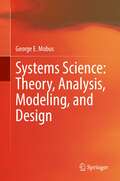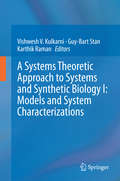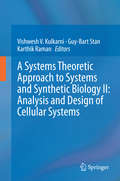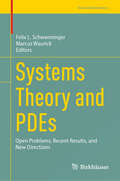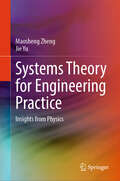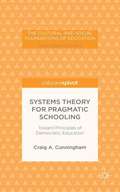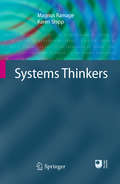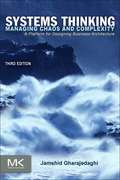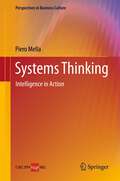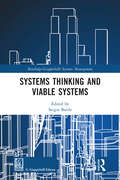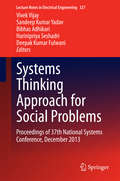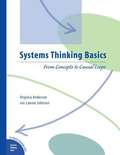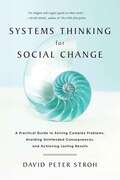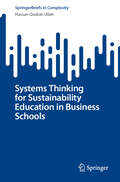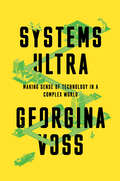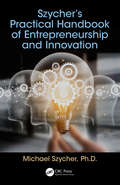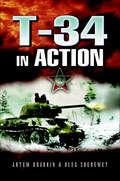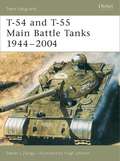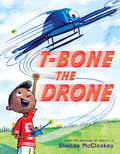- Table View
- List View
Systems Science Level 4
by Cheryl Chiapperino Macki Jones Sheri Leasure Lisa WoodA science book set for Christian educators and schools worldwide. Topics covered include: life science: stability, physical sciences, earth & space: balance and human body wellness.
Systems Science: Theory, Analysis, Modeling, and Design
by George E. MobusThis book describes a comprehensive approach to applying systems science formally to the deep analysis of a wide variety of complex systems. Detailed ‘how-to’ examples of the three phases (analysis-modeling-design) of systems science are applied to systems of various types (machines, organic (e.g. ecosystem), and supra-organic (e.g. business organizations and government). The complexity of the global system has reached proportions that seriously challenge our abilities to understand the consequences of our use of technology, modification of natural ecosystems, or even how to govern ourselves. For this reason, complex mathematics is eschewed when simpler structures will suffice, allowing the widest possible audience to apply and benefit from the available tools and concepts of systems science in their own work. The book shows, in detail, how to functionally and structurally deconstruct complex systems using a fundamental language of systems. It shows how to capture the discovered details in a structured knowledge base from which abstract models can be derived for simulation. The knowledge base is also shown to be a basis for generating system design specifications for human-built artifacts, or policy recommendations/policy mechanisms for socio-economic-ecological systems management. The book builds on principles and methods found in the authors’ textbook Principles of Systems Science (co-authored with Michael Kalton), but without prerequisites. It will appeal to a broad audience that deals with complex systems every day, from design engineers to economic and ecological systems managers and policymakers.
A Systems Theoretic Approach to Systems and Synthetic Biology I: Models And System Characterizations
by Vishwesh V. Kulkarni Guy-Bart Stan Karthik RamanThe complexity of biological systems has intrigued scientists from many disciplines and has given birth to the highly influential field of systems biology wherein a wide array of mathematical techniques, such as flux balance analysis, and technology platforms, such as next generation sequencing, is used to understand, elucidate, and predict the functions of complex biological systems. More recently, the field of synthetic biology, i. e. , de novo engineering of biological systems, has emerged. Scientists from various fields are focusing on how to render this engineering process more predictable, reliable, scalable, affordable, and easy. Systems and control theory is a branch of engineering and applied sciences that rigorously deals with the complexities and uncertainties of interconnected systems with the objective of characterising fundamental systemic properties such as stability, robustness, communication capacity, and other performance metrics. Systems and control theory also strives to offer concepts and methods that facilitate the design of systems with rigorous guarantees on these properties. Over the last 100 years, it has made stellar theoretical and technological contributions in diverse fields such as aerospace, telecommunication, storage, automotive, power systems, and others. Can it have, or evolve to have, a similar impact in biology? The chapters in this book demonstrate that, indeed, systems and control theoretic concepts and techniques can have a significant impact in systems and synthetic biology. Volume I provides a panoramic view that illustrates the potential of such mathematical methods in systems and synthetic biology. Recent advances in systems and synthetic biology have clearly demonstrated the benefits of a rigorous and systematic approach rooted in the principles of systems and control theory - not only does it lead to exciting insights and discoveries but it also reduces the inordinately lengthy trial-and-error process of wet-lab experimentation, thereby facilitating significant savings in human and financial resources. In Volume I, some of the leading researchers in the field of systems and synthetic biology demonstrate how systems and control theoretic concepts and techniques can be useful, or should evolve to be useful, in order to understand how biological systems function. As the eminent computer scientist Donald Knuth put it, "biology easily has 500 years of exciting problems to work on". This edited book presents but a small fraction of those for the benefit of (1) systems and control theorists interested in molecular and cellular biology and (2) biologists interested in rigorous modelling, analysis and control of biological systems.
A Systems Theoretic Approach to Systems and Synthetic Biology II: Analysis And Design Of Cellular Systems
by Vishwesh V. Kulkarni Guy-Bart Stan Karthik RamanThe complexity of biological systems has intrigued scientists from many disciplines and has given birth to the highly influential field of systems biology wherein a wide array of mathematical techniques, such as flux balance analysis, and technology platforms, such as next generation sequencing, is used to understand, elucidate, and predict the functions of complex biological systems. More recently, the field of synthetic biology, i. e. , de novo engineering of biological systems, has emerged. Scientists from various fields are focusing on how to render this engineering process more predictable, reliable, scalable, affordable, and easy. Systems and control theory is a branch of engineering and applied sciences that rigorously deals with the complexities and uncertainties of interconnected systems with the objective of characterising fundamental systemic properties such as stability, robustness, communication capacity, and other performance metrics. Systems and control theory also strives to offer concepts and methods that facilitate the design of systems with rigorous guarantees on these properties. Over the last 100 years, it has made stellar theoretical and technological contributions in diverse fields such as aerospace, telecommunication, storage, automotive, power systems, and others. Can it have, or evolve to have, a similar impact in biology? The chapters in this book demonstrate that, indeed, systems and control theoretic concepts and techniques can have a significant impact in systems and synthetic biology. Volume II contains chapters contributed by leading researchers in the field of systems and synthetic biology that concern modeling physiological processes and bottom-up constructions of scalable biological systems. The modeling problems include characterisation and synthesis of memory, understanding how homoeostasis is maintained in the face of shocks and relatively gradual perturbations, understanding the functioning and robustness of biological clocks such as those at the core of circadian rhythms, and understanding how the cell cycles can be regulated, among others. Some of the bottom-up construction problems investigated in Volume II are as follows: How should biomacromolecules, platforms, and scalable architectures be chosen and synthesised in order to build programmable de novo biological systems? What are the types of constrained optimisation problems encountered in this process and how can these be solved efficiently? As the eminent computer scientist Donald Knuth put it, "biology easily has 500 years of exciting problems to work on". This edited book presents but a small fraction of those for the benefit of (1) systems and control theorists interested in molecular and cellular biology and (2) biologists interested in rigorous modelling, analysis and control of biological systems.
Systems Theory and PDEs: Open Problems, Recent Results, and New Directions (Trends in Mathematics)
by Felix L. Schwenninger Marcus WaurickThis volume presents recent advances and open problems in the cross section of infinite-dimensional systems theory and the modern treatment of PDEs. Chapters are based on talks and problem sessions from the first “Workshop on Systems Theory and PDEs” (WOSTAP), held at TU Bergakademie Freiberg in July 2022. The main topics covered include: Differential algebraic equations Port-Hamiltonian systems in both finite and infinite dimensions Highly nonlinear equations related to elasticity/plasticity Modeling of thermo-piezo-electromagnetism
Systems Theory for Engineering Practice: Insights from Physics
by Maosheng Zheng Jie YuThis book presents cognition of the universality of systems theory thinking by using some ordinary physical phenomena and their methods in study, of which the involved treatments are consistent with the viewpoint of systems theory. It contains the collective actions of classical vibration of many bodies and wave, the extreme value problem in natural world, status of electrons in atom-molecule and metals, Ising model in phase transition and elementary excitation in solid, multi-objective optimization in a system, description of effective media approximation, certainty in uncertain phenomena, all these reflect the cooperative/synergetic effects, wholeness of group actions, “unity of opposites” inside a system, and collective phenomena in a system completely. The relevant methodologies for systems theory are organic combination and synergism of both “reductionism” and “holism” instead of “confrontation” or “separation” of them, which could be used in dealing with analogous problems in systems science and engineering fields in response to the idiom of “stones from other hills being good for polishing this jade” and “comprehend by analogy”, so as to promote the transformation of wisdom to productivity. The authors wish this work could play its role as a paving stone to serve the research and application of systems theory. This book can be used as a textbook for postgraduate and advanced undergraduate students in relevant majors, and a reference book for scientists and practitioners in related fields.
Systems Theory for Pragmatic Schooling: Toward Principles of Democratic Education
by Craig A. CunninghamWriting for educators and education leaders, Cunningham shows that combining a philosophy of pragmatism with thinking about education as systems can illuminate challenges in contemporary schooling and provide practical solutions for creating a democratic education.
Systems Thinkers
by Karen Shipp Magnus RamageThis book presents a biographical history of the field of systems thinking, by examining the life and work of thirty of its major thinkers. It discusses each thinker's key contributions, the way this contribution was expressed in practice and the relationship between their life and ideas. This discussion is supported by an extract from the thinker's own writing, to give a flavour of their work and to give readers a sense of which thinkers are most relevant to their own interests.
Systems Thinking: Managing Chaos And Complexity: A Platform For Designing Business Architecture
by Jamshid GharajedaghiSystems Thinking, Third Edition combines systems theory and interactive design to provide an operational methodology for defining problems and designing solutions in an environment increasingly characterized by chaos and complexity. This new edition has been updated to include all new chapters on self-organizing systems as well as holistic, operational, and design thinking. <p><p> The book covers recent crises in financial systems and job markets, the housing bubble, and environment, assessing their impact on systems thinking. A companion website is available at interactdesign.com. <p> This volume is ideal for senior executives as well as for chief information/operating officers and other executives charged with systems management and process improvement. It may also be a helpful resource for IT/MBA students and academics.
Systems Thinking: Intelligence in Action
by Piero MellaThe core belief underlying this book is that the most useful and effective models to strengthen our intelligence are system ones, developed following the logic of Systems Thinking. Such models can explore complexity, dynamics, and change, and it is the author's view that intelligence depends on the ability to construct models of this nature. The book is designed to allow the reader not only to acquire simple information on Systems Thinking but above all to gradually learn the logic and techniques that make this way of thinking an instrument for the improvement of intelligence. In order to aid the learning and practice of the Systems Thinking discipline, the author has abandoned a rigid formal language for a more discursive style. He writes in the first person, with an ample number of citations and critical analyses, and without ever giving in to the temptation to use formal mathematics.
Systems Thinking: From Heresy to Practice
by Keivan Zokaei John Seddon Brendan O'DonovanSystems Thinking is a topic which is at the forefront of how we think about management in the Public Sector and Service Industries. This collection from leading thinkers in the field takes a case study approach to a variety of issueswhich encompass topics such as Banking, Electrical Distribution, Manufacturing andAdult Social Care. "
Systems Thinking and Viable Systems (Routledge-Giappichelli Systems Management)
by Sergio BarileIn the last few decades, managerial and business studies have shown an increasing inability to explain and forecast emergent dynamics in society, economics, and the environment.Consolidated managerial approaches and business theories seem to be incapable of communicating and depicting the ongoing evolution, and new perspectives are required to support both researchers and practitioners in tracing new paths for development. Building upon the constructivist approach, this book illustrates the multiple advantages that systems thinking can offer in supporting a holistic understanding of social and economic phenomena.The book proposes a representation of the firm as a viable system and represents its functioning and decision-making processes trough a recursive depiction that can be applied for each of the multiple levels through which socio-economic environments are defined. As a result of the focus on the differences between decision making and problem-solving processes, the book enriches current knowledge about systems thinking and provides useful instruments through which both researchers and practitioners can effectively understand the multiple variables able to influence decisions and actions within a firm’s configuration.The book is aimed at both postgraduate students and researchers interested in the multiple dimensions of systems thinking.
Systems Thinking Approach for Social Problems
by Vivek Vijay Sandeep Kumar Yadav Bibhas Adhikari Harinipriya Seshadri Deepak Kumar FulwaniThe book is a collection of peer-reviewed scientific papers submitted by active researchers in the 37th National System Conference (NSC 2013). NSC is an annual event of the Systems Society of India (SSI), primarily oriented to strengthen the systems movement and its applications for the welfare of humanity. A galaxy of academicians, professionals, scientists, statesman and researchers from different parts of the country and abroad are invited to attend the conference. The book presents research articles in the areas of system's modelling, complex network modelling, cyber security, sustainable systems design, health care systems, socio-economic systems, and clean and green technologies. The book can be used as a tool for further research.
Systems Thinking Basics: From Concepts to Causal Loops
by Virginia Anderson Lauren Johnson<p>Systems Thinking Basics is a self-study, skill-building resource designed to introduce you to the power of systems thinking tools. With an emphasis on behavior over time graphs and causal loop diagrams, this workbook guides you step by step through: Recognizing systems and understanding the importance of systems thinking; Interpreting and creating behavior over time graphs and causal loop diagrams; Applying and practicing systems thinking day-to-day. <p>Each of the book's six main sections contains a wealth of examples from the business world, as well as learning activities that reinforce concepts and provide you with the opportunity and space to practice. An array of appendices offers: Extra practice activities; A summary of key points and suggested responses to the learning activities; A table showing the "palette" of systems thinking tools available; A glossary of systems thinking terms; A list of additional resources; A summary of the systems archetypes. <p>The many diagrams within the book clarify concepts and visually reinforce key principles. Systems Thinking Basics is ideal for aspiring systems thinkers eager to try their hand at using these powerful tools</p>
Systems Thinking for Social Change: A Practical Guide to Solving Complex Problems, Avoiding Unintended Consequences, and Achieving Lasting Results
by David Peter StrohConcrete guidance on how to incorporate systems thinking in problem solving, decision making, and strategic planning―for everyone! <p><p>Donors, leaders of nonprofits, and public policy makers usually have the best of intentions to serve society and improve social conditions. But often their solutions fall far short of what they want to accomplish and what is truly needed. Moreover, the answers they propose and fund often produce the opposite of what they want over time. We end up with temporary shelters that increase homelessness, drug busts that increase drug-related crime, or food aid that increases starvation. <P><P>How do these unintended consequences come about and how can we avoid them? By applying conventional thinking to complex social problems, we often perpetuate the very problems we try so hard to solve, but it is possible to think differently, and get different results. <P><P>Systems Thinking for Social Change enables readers to contribute more effectively to society by helping them understand what systems thinking is and why it is so important in their work. It also gives concrete guidance on how to incorporate systems thinking in problem solving, decision making, and strategic planning without becoming a technical expert.
Systems Thinking for Sustainability Education in Business Schools (SpringerBriefs in Complexity)
by Hassan Qudrat-UllahThis book delves into the current state and future prospects of systems thinking and sustainability education within business schools. It meticulously examines the trends and drivers shaping the demand and supply of such education, along with the implications and challenges it presents for various stakeholders and society at large. Strategic recommendations and suggestions are provided to elevate and propel systems thinking and sustainability education in business schools, outlining a visionary roadmap for the future. Furthermore, the book explores the intersectionality of sustainability and diversity in business education, offering examples and cases of visionary and innovative initiatives and projects in the field. Distinguished by special features such as illustrations, the book offers a comprehensive and integrative overview of the current landscape and future trajectories of systems thinking and sustainability education in business schools. The primary benefit for readers lies in gaining a deeper and broader understanding of systems thinking and sustainability education in business schools. It equips them with the knowledge to apply systems thinking and sustainability principles and tools to tackle the complex and wicked problems of the twenty-first century. Additionally, the book aims to inspire and inform business schools and their stakeholders to embrace and enhance systems thinking and sustainability education in their curricula and pedagogy, contributing to the advancement of sustainability and systems thinking in both business and society.
Systems Ultra: Making Sense of Technology in a Complex World
by Georgina VossA TOOLBOX FOR COMPREHENDING — AND CHANGING — THE WORLDSystems Ultra explores how we experience complex systems: the mesh of things, people, and ideas interacting to produce their own patterns and behaviours.What does it mean when a car which runs on code drives dangerously? What does massmarket graphics software tell us about the workplace politics of architects? And, in these human-made systems, which phenomena are designed, and which are emergent? In a world of networked technologies, global supply chains, and supranational regulations, there are growing calls for a new kind of literacy around systems and their ramifications. At the same time, we are often told these systems are impossible to fully comprehend and are far beyond our control.Drawing on field research and artistic practice around the industrial settings of ports, air traffic control, architectural software, payment platforms in adult entertainment, and car crash testing, Georgina Voss argues that complex systems can be approached as sites of revelation around scale, time, materiality, deviance, and breakages. With humour and guile, she tells the story of what &‘systems&’ have come to mean, how they have been sold to us, and the real-world consequences of the power that flows through them.Systems Ultra goes beyond narratives of technological exceptionalism to explore how we experience the complex systems which influence our lives, how to understand them more clearly, and, perhaps, how to change them.
The Systems View of Life
by Pier Luigi Luisi Fritjof CapraOver the past thirty years, a new systemic conception of life has emerged at the forefront of science. New emphasis has been given to complexity, networks, and patterns of organisation leading to a novel kind of 'systemic' thinking. This volume integrates the ideas, models, and theories underlying the systems view of life into a single coherent framework. Taking a broad sweep through history and across scientific disciplines, the authors examine the appearance of key concepts such as autopoiesis, dissipative structures, social networks, and a systemic understanding of evolution. The implications of the systems view of life for health care, management, and our global ecological and economic crises are also discussed. Written primarily for undergraduates, it is also essential reading for graduate students and researchers interested in understanding the new systemic conception of life and its implications for a broad range of professions - from economics and politics to medicine, psychology and law.
Systemverfahrenstechnik in der Ingenieurspraxis: Beherrschung von Prozessen, Gefährdungen und Reinheitskriterien
by Bernd EbertDas Buch behandelt die für das Optimum verfahrenstechnischer Prozesse unerlässliche System-Betrachtung. Diese sollte nicht nur für den „reinen“ Prozess erfolgen, sondern für den gesamten Lebenszyklus technischer Anlagen – vom Entwurf eines Prozesses bis zur Optimierung im laufenden Betrieb. Dabei kommt es nicht nur auf den Normalbetrieb an (wie häufig bei Simulationen betrachtet), sondern auch auf An- und Abfahrprozesse, das Havarie-/Störungsverhalten der Prozesse, die Reinigungsabläufe, Sicherheitsmaßnahmen usw. Geeignete Analyse- und Betrachtungsmethoden werden dazu vorgestellt, die sich in langjähriger Planungs- und Betriebspraxis herausgebildet haben. Hierzu zählen u.a. Risikoanalysen, Zeitdynamik- und Zuverlässigkeitsmethoden; deren theoretischer Ansatz wird mit ihrer praktischen Anwendbarkeit verbunden. Auch Aspekte wie Industrie 4.0 und Prozessänderungen bei laufenden Anlagen werden betrachtet. Damit soll ein Beitrag sowohl für die Ingenieurausbildung, die technische Betriebsbetreuung als auch für die Projektabwicklung geleistet werden.
Szycher's Dictionary of Medical Devices
by Michael SzycherFROM THE PREFACEThe field of medical devices represents one of the most advanced technological areas in the United States. In 1991, over 12 million Americans had at least one medical device; fixation devices had the highest incidence, followed by contact lens use and lens implants and, lastly, artificial joints. The public has come to expect that medical devices will alleviate maladies and/or conditions that were not treatable fifty years ago. It is hard to believe that the first pacemaker was invented in the 1950s, the first artificial heart valve in 1952, and the first artificial hip replacement was performed in 1954. In 1992, the medical device industry exported a total of $6.9 billion, while the country imported a total of $3.9 billion, representing a $3.0 billion trade surplus. Medical devices are among the most regulated products in the world. The FDA maintains a constant vigil over medical device manufacturers and importers; even medical device definitions are subject to official scrutiny. Title 21 of the Code of Federal Regulations publishes these definitions, but the definitions are spread over several medical specialty areas and are, thus, difficult to find. This book attempts to bring a measure of order by providing an alphabetical listing of officially defined devices.
Szycher's Handbook of Polyurethanes
by Michael SzycherA practical handbook rather than merely a chemistry reference, Szycher's Handbook of Polyurethanes, Second Edition offers an easy-to-follow compilation of crucial new information on polyurethane technology, which is irreplaceable in a wide range of applications. This new edition of a bestseller is an invaluable reference for technologists, marketer
Szycher’s Practical Handbook of Entrepreneurship and Innovation
by Michael SzycherThis practical and comprehensive handbook offers step-by-step instruction, guiding entrepreneurs of innovative technology startups all the way from idea to profitability. With its easy-to-follow format aimed at both experienced as well as novice entrepreneurs, this book covers all technical, financial, legal, and governmental hurdles facing startups. It discusses common causes of business failure and points out the pitfalls to avoid in getting innovative technology successfully to market.
T-34 in Action: Soviet Tank Troops In World War Ii (Stackpole Military History Ser.)
by Artem Drabkin Oleg SheremetFirst-hand accounts from the Russian veterans of World War II who fought in the celebrated tanks that powered the Soviet armored forces. The Soviet T-34 medium tank was one of the most famous and effective fighting vehicles of the Second World War. Along with the German Tiger and the American Sherman, it was a milestone in tank design that changed the course of the conflict. Much has been written about the technical history of the tank and the vital part it played in the huge tank battles on the Eastern Front, but less has been said about the men who went to war in the T-34 and lived, fought and sometimes died in these remarkable machines. This pioneering book, which is based on extensive interviews with tank crews, records their experiences and offers a compelling inside view of armored warfare in the mid-twentieth century. &“An engaging book, and you will find yourself feeling the discomfort, anxiety, fear, pride and joy of a Soviet Tanker in WWII as you read the T-34 in Action.&”—Military Trader &“An excellent read and a good book for tank enthusiasts.&”—The Armourer
T-54 and T-55 Main Battle Tanks, 1944-2004
by Steven J. ZalogaThe T-54 and T-55 tanks are the most widely manufactured tanks of all time. They have become ubiquitous to wars around the globe since the 1950s, starting with Hungary in 1956, and including the the Arab-Israeli wars of 1967, 1973 and 1982, the Vietnam war of 1967-75, the Iran-Iraq War of 1980-88, the Afghanistan conflict, Operation Desert Storm, the Yugoslav Civil Wars, and the recent conflict in Iraq. This book will examine the roots of this prolific tank family, starting with the Soviet Army's first attempts to replace the legendary T-34 during World War II, and covering the T-43 and the T-44, the more successful T-54, and its ultimate evolution into the T-55.
T-Bone the Drone
by Shanda McCloskeyA new tech toy brings epic trials and triumphs in this playtime adventure for fans of The Most Magnificent Thing and Iggy Peck, Architect.Lucas has a new best friend when he bring T-Bone the Drone home from the store. They enjoy playing, flying, and even recharging together--but Lucas has been spending so much time with his new toy that he's on the sidelines when he tries to join the neighborhood Wiffle ball game. When the ball sails over the fence where a scary dog lives, it's the perfect opportunity for Lucas and T-Bone to do what friends do best: work together! It turns out that they'll need help from the whole team, though, to save the day...Finding the solution takes a little ingenuity and a lot of teamwork in this companion story to Doll-E 1.0 celebrating the inventive spirit of modern play.

